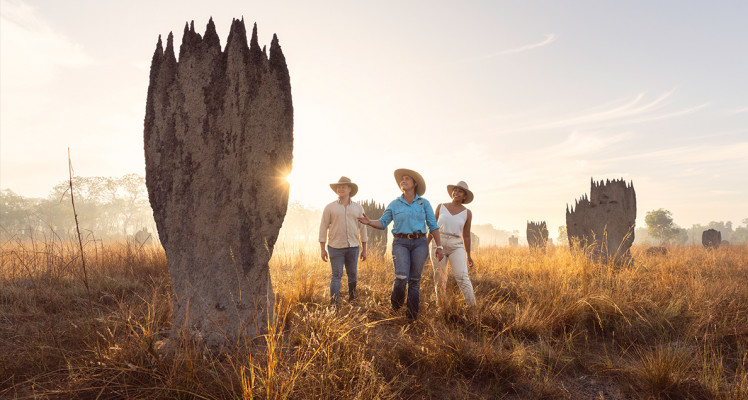Purchase wisely
You can manage your waste and have a positive impact on our local community through sustainable procurement. The purchases you make have the power to create either positive or negative impacts on the Territory’s people, community, economy, and natural environment. To maximise the contribution of your cash, you should consider whether you need the item, how the item was made, where it was made, and the packaging it will arrive in.

Managing waste
There are simple solutions you can employ to significantly reduce your waste. As a start, remember the five R’s: Refuse, Reduce, Reuse, Repurpose, and Recycle.
While recycling seems simple, there are lots of misconceptions - for example, did you know that your recyclables must not be placed inside a plastic bin bag? You can check here to determine whether you are recycling and disposing of your waste correctly. Alternatively, get in touch with your local council to find out what options are available if your region.

Get started
To commence your transformation into a sustainable tourism business, we have compiled key focal points and actionable steps for implementing sustainable practices into your operations.
- Transition away from single use plastics.
- Provide a free drinking water refill station (can you also provide refillable water bottles to your visitors?).
- Ditch plastic straws, water bottles, cutlery, plates, and bags.
- Avoid plastic packaging, especially if it can’t be recycled or if recycling options are limited. - Reduce the amount you print, using tech-based or other solutions when you can. Use recycled printer paper and ensure your recycle your printer cartridges, paper and cardboard. Go to Planet Ark to find out your recycling options.
- Research what items are recyclable and encourage staff and visitors to recycle responsibly.
- Train staff and display signs about waste avoidance practices and encourage visitors to carry a suitable container to store their rubbish until the next appropriate bin or recycling station, or do it for them.
- Aim to purchase items that can be composted, repurposed, or recycled, and choose items packaged in sustainable materials.
- Support local businesses with your purchases, especially those with clear social, cultural and environmental commitments.
- Research your supply chain’s targets and achievements, and encourage them to follow you in your sustainable practices.

Take further action
The below checklist aims to inspire you to transcend the ordinary and embrace inventive approaches that champion environmental stewardship, uplift local communities, and provide genuine and responsible travel experiences.
- Introduce a composting station, worm farm, or Bokashi composting bin to transfer your organic waste into a valuable resource. If a large compost is required, invest in a commercial composter. There are lots of options on market, make sure you do your research to procure the more sustainable and effective product.
- Compost is great for the garden, retaining moisture, insulating plant roots, and fixing sandy soils. Your staff, visitors and garden will love it!
- If you can’t compost, research your local waste management facility to find out if they will accept your green/organic waste, often this is managed by your local council. It can be tempting to put your organic waste into your general waste bin, however this waste released significant carbon emissions to the atmosphere
- Encourage staff and visitors to participate in one of the Great Northern Clean Up events held in the NT between August and October every year. Can you include this in your product offering? Remember, visitors are looking for regenerative travel options!
- Undertake a procurement audit and develop a strategy to transition to local and sustainable suppliers. It will also help you to determine if:
- you could procure items made from more sustainable materials
- you could transition to suppliers that actively support and positively contribute to sustainability
- your supply chain risks are at an acceptable level*
*See table below. - Complete a waste audit and develop a strategy to identify areas of weakness or opportunities to repurpose. It will also help you determine if:
- items are being thrown away before they have been fully used
- items are being thrown into the correct bins
- there are items that could be recycled using alternative methods and solutions
- there are items that could be repurposed. - Distribute annual voluntary screening surveys to your suppliers to improve your understanding of their sustainability performance and encourage them to reflect on their sustainability practices.
- Establish a procurement policy to uphold values of sustainable purchasing that will prioritise local community, prosperity, and sustainability.
Supply chain risks
According to the Sustainable Accounting Standards Board, supply chain risks you should be aware of include:
| Labour conditions | Environmental health and safety | Reputational risks due to environmental or social impacts |
|---|---|---|
|
|
|
An emission of something, such as gas or vapor, is the release of it into the atmosphere.
A specific set of gas emission associated with human activities that alter the Earth’s climate are called greenhouse gas emissions.
Biodiversity is all the different kinds of life you'll find in one area - the variety of animals, plants, fungi, and even microorganisms like bacteria that make up our natural world. Each of these species and organisms work together in ecosystems, like an intricate web, to maintain balance and support life.
